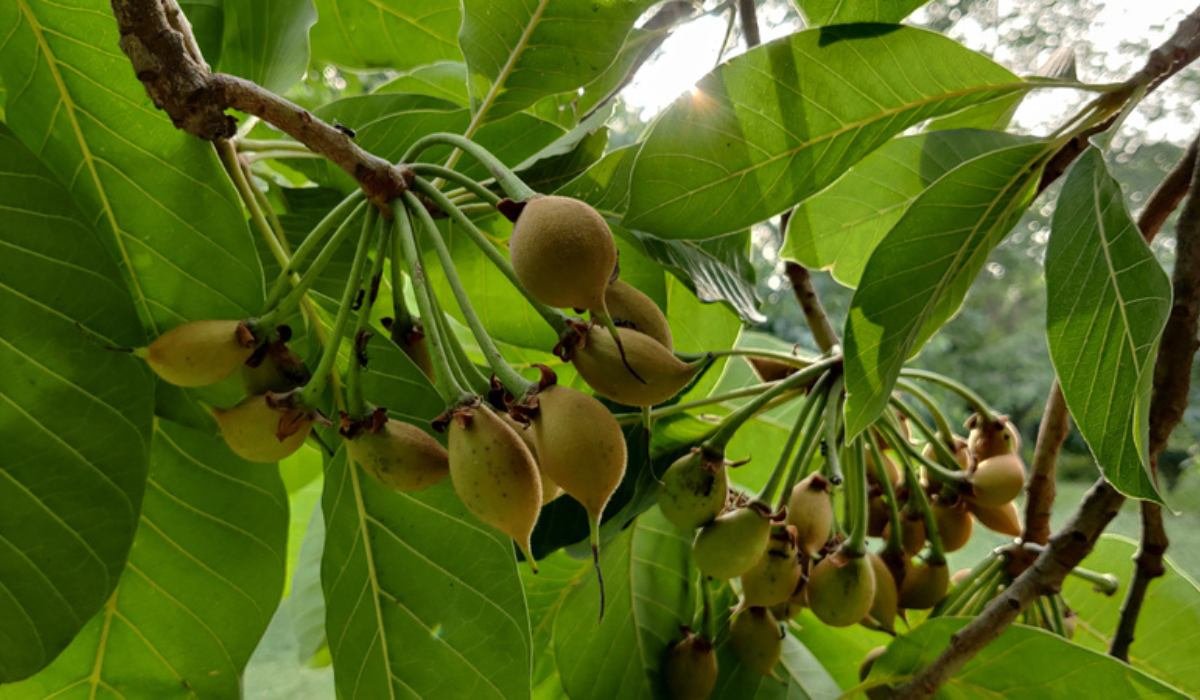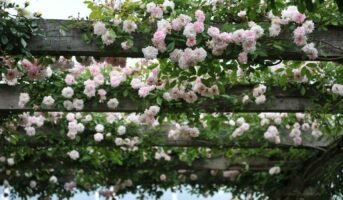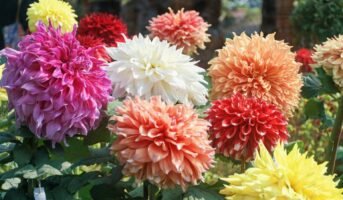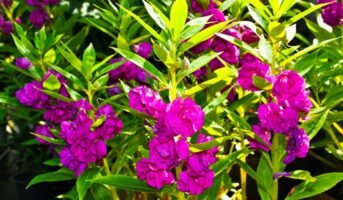The Madhuca longifolia is a species of tropical tree native to India that may be found primarily on the plains and forests of the central, southern, and northern parts of the country, as well as in Nepal, Myanmar, and Sri Lanka. It is a quick-growing tree that may reach a height of roughly 20 metres, with everlasting or semi-evergreen foliage.
Since it’s a tall tree, you’ll need a huge backyard to be able to plant it outside your house. It is tolerant of dry settings and is a prominent tree in tropical mixed deciduous forests.
Madhuca Longifolia: Key facts
| Botanical Name | Madhuca longifolia |
| Family | Sapotaceae |
| Common Name | Butter Tree, Mahua, Illipe |
| Habitats | Boreal forest edges in Nepal, at altitudes of up to 200 metres. It is common to see this tree growing in the wild among central India’s grasslands and plains. |
| Height | 70 ft. |
| Ideal Temperature | Within 2 – 46°C |
| Maintenance | Very Low |
| Ideal location for placement | Wide open spaces like backyards and fields. |
See also: What is mint and what are its numerous benefits?
Madhuca Longifolia: Physical description
- Originally from India, Sri Lanka, Nepal, and Myanmar, mahua is a hardy plant that may thrive at the fringes of dry tropical and subtropical forests up to an altitude of 1200–1800 m.
- It grows sporadically in semi-evergreen woods, along riverbanks, and pastures and crop fields in central India.
- It has a short, thick trunk with a diameter of 80 cm.
- The crown has several branches and is circular.
- The leaves are alternating and crowded at the branchlets’ terminals. The basic leaf blade measures 10-25 cm in length and 6-12 cm in width, is oval-shaped, stiff, thick, and hard, woolly on the underside, and exudes a milky sap when broken.
- Young leaves are pinkish or crimson-brown. Blooms are borne on green or pink, hairy clusters, with each cluster containing 12 fragrant, white flowers.
- Pollinated blooms produce a meaty, greenish-yellow ovoid fruit with one to four lustrous, oily brown seeds.
- The seeds are 3 to 5 centimetres long, oval, and one-sidedly flattened.

Source: Wikipedia
Madhuca Longifolia: Growing tips
- The plant is native to the subtropics and hot tropics and grows at altitudes of up to 1,200 metres.
- Due to its moderate frost tolerance, it thrives in climates where average yearly daytime temperatures are between 2 and 46 degrees Celsius.
- It does best in areas that get between 550 and 1,500 millimetres of rain annually on average.
- A sunny location is a must.
- Although mahua thrives on well-drained loamy or sandy-loam soils, it may also be found in shallow stony, clayey, and calcareous soils.
- It is a long-lived tree that begins giving fruit after around ten years.
- The maximum annual bloom yield for a mature tree is 90 kg.
- The resulting crop is of high quality if trees are cut down during their dormant summer months.
- They have a coppice cycle of 25–30 years with an average yearly growth rate of 3-5 cubic metres.
See also: What is hibiscus and what are its many benefits?
Madhuca Longifolia: Care tips
Since it is a big plant, it can’t be grown in a house with a small area. You need to have an open space big enough to hold the plant’s roots and branches. It is a wild plant usually grown in the forest. It requires a hot and humid temperature as it is mainly grown in the southern central part of India.
One of the main things is that it requires a significant amount of rainfall which implies that these plants need to be watered quite often. No special kind of fertiliser is necessary to grow this plant; it is just the climatic aptitude of this plant that needs to be fulfilled.
Mahua tree: Sunlight requirements
The Mahua tree, native to India, thrives in abundant sunlight. It is important to choose a location that receives a minimum of 5-6 hours of direct sunlight each day. Growing the tree in a shaded area can result in stunted growth and no fruit production.
Mahua tree: Watering requirements
During the early stages of growth, it is crucial to monitor the watering of the plant. Water the tree when the topsoil feels slightly dry to the touch. Continue this watering regimen until the Mahua tree reaches a height of about 5-6 feet. Once established, the tree will manage its watering needs independently.
Mahua tree: Soil requirements
The Mahua tree is not demanding when it comes to the type of soil it grows in. Regular garden soil is sufficient for its growth. However, for enhanced growth, incorporating organic matter, vermicompost, cow dung manure, and coco peat into the soil at the time of planting can be beneficial.
Mahua tree: Fertiliser requirements
If you have used a nutrient-rich growing medium, there is no need to provide additional fertilizer. The tree will continue to flourish as long as it receives ample sunlight. However, during the initial stages of growth, adding cow dung manure to the soil can promote faster development.
Mahua tree: Pruning requirements
To maintain the desired shape of the tree, it is advisable to prune away any dead or damaged stems and leaves, particularly when the tree is young. Once the Mahua tree reaches maturity, pruning becomes less necessary, and the tree will require minimal attention in this regard.
Mahua tree: Pests and diseases
When the Mahua tree is young, it may be susceptible to pests such as spider mites, mimosa webworms, mealybugs, thrips, aphids, and scales. Non-toxic horticultural oil can be used to effectively control these pests. As the tree grows and develops, it will develop its own resilience and natural defences against pests and diseases.
Madhuca Longifolia: Uses
The key uses of the Mahua plant are as follows:
- Several different portions of the tree, particularly the bark, are utilised for the therapeutic benefits they possess. Patients with diabetes in Nepal are given a decoction made from the tree’s bark.
- Leprosy is often treated using a medicinal extract made from the tree’s bark. The oil that is extracted from the seeds is utilised in the treatment of a variety of skin conditions. The seed cakes that are left over after the oil has been extracted make for excellent fertiliser.
- The flowers are thought to provide a calming, tonifying, and demulcent effect. They are employed in the therapy of coughs, colds, and bronchitis, among other conditions.
- The succulent, sugary flowers can be consumed as fresh or dried, powdered and baked with flour, fermented to produce alcohol, or used as a sweetener.
- Given its non-toxicity, the inhabitants of Western Odisha rely heavily on mahua fruit as a primary source of nutrition. The tree holds a significant place in the local culture. Its fruits and blooms are used in the preparation of a wide variety of delicious foods.
- The fruit’s edible component is the pulpy rind that surrounds the pit. When there is a grain shortage in the local region, a mixture of mahua flowers and sal seeds is cooked together to make a dish that may be used as a substitute for grain staples.
Silk Production
Antheraea paphia, a species of moth that is important to India’s economy due to the production of tussar silk, feeds on the leaves of Madhuca indica. Tussar silk is a sort of wild silk. The leaves, flowers, and fruits are also chopped off to feed goats and sheep.
Culling features
Supposedly, the alkaloids included in the press cake derived from mahua seeds are utilised in some areas of India to cull fish populations in aquaculture ponds. The cake serves the purpose of fertilising the pond, which may then be emptied, sun-dried, replenished with water, and supplied with fish fingerlings.
Madhuca Longifolia: Benefits
In the current scenario, people run towards the beauty of things, and this plant is the perfect blend of beauty and its other uses. Its perks are in abundance. Its large and shallow root system ties the soil, thus reducing the amount of erosion.

Source: Wikipedia
FAQs
Which Indian state is known for mahua?
In India, it is mostly found in Western Odisha.
How fast does the mahua tree grow?
It attains a height of 70 ft in the period of the first 8-15 years.
Why is the mahua tree one of the most important Indian forest trees?
The mahua tree is one of the most important Indian forest trees due to its plethora of benefits, ranging from medicinal to commercial.
Housing News Desk is the news desk of leading online real estate portal, Housing.com. Housing News Desk focuses on a variety of topics such as real estate laws, taxes, current news, property trends, home loans, rentals, décor, green homes, home improvement, etc. The main objective of the news desk, is to cover the real estate sector from the perspective of providing information that is useful to the end-user.
Facebook: https://www.facebook.com/housing.com/
Twitter: https://twitter.com/Housing
Email: [email protected]











